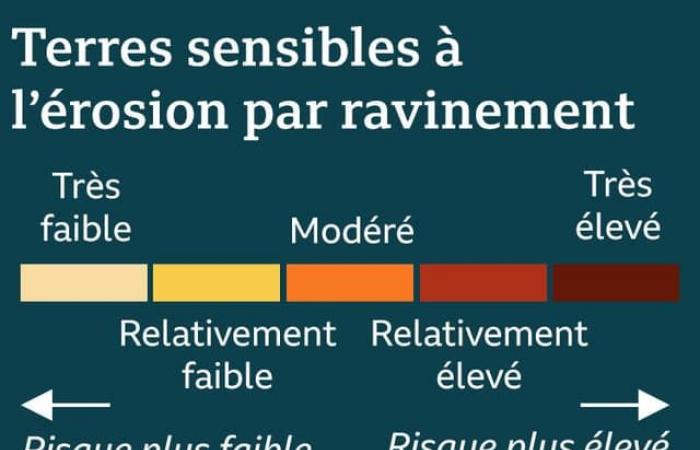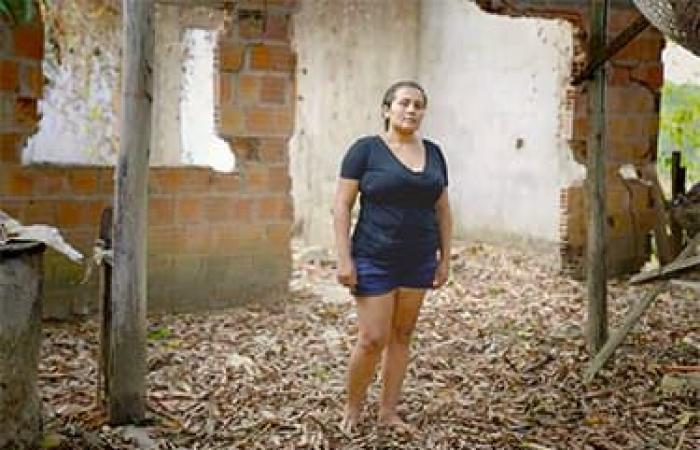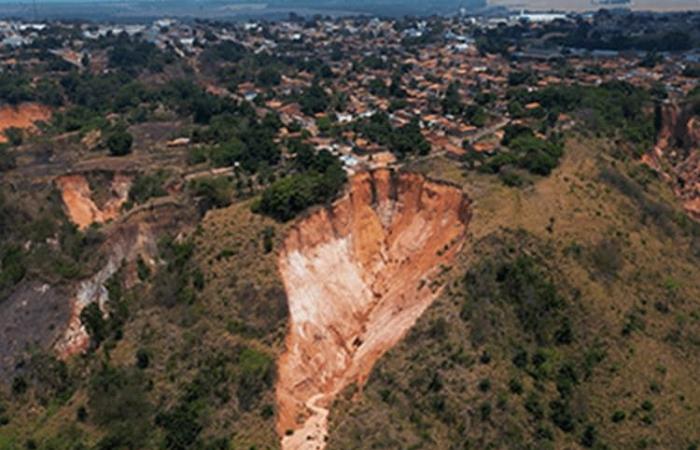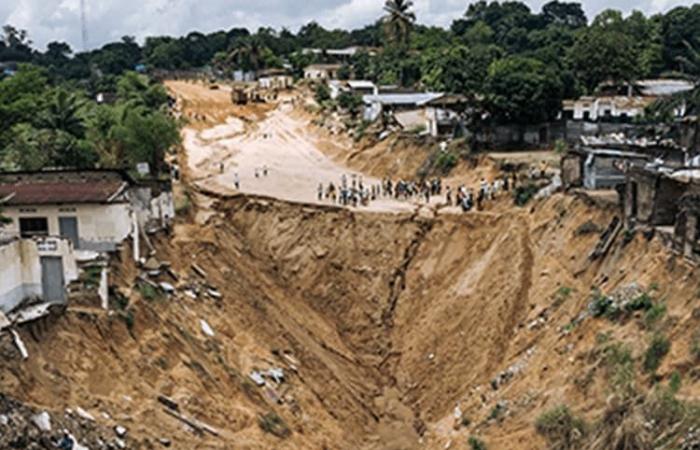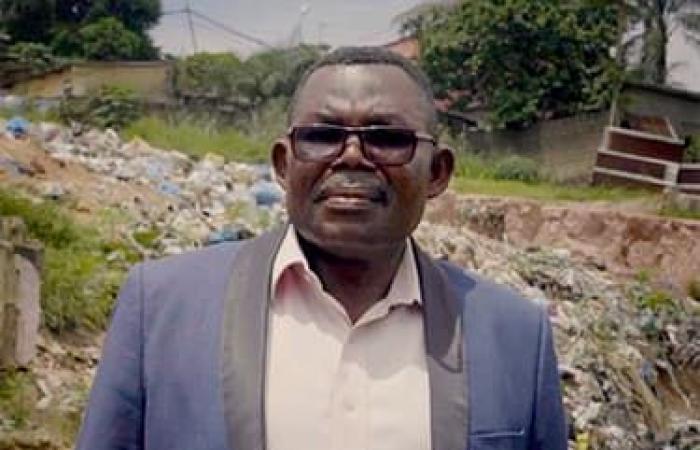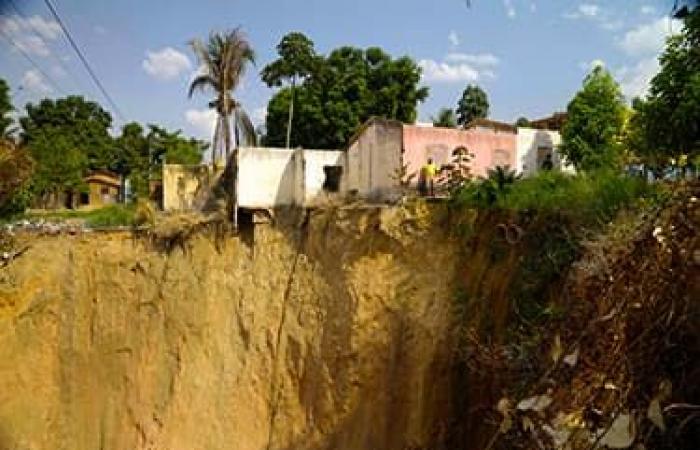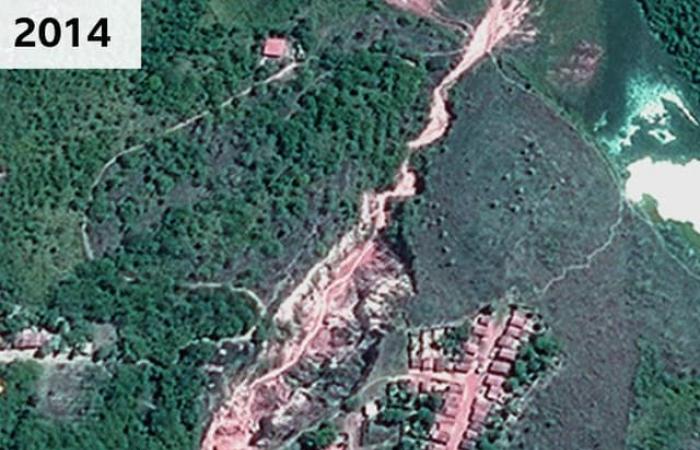Former police officer José Ribamar Silveira almost died when he fell into this ravine.
He got lost while driving home from a party one evening in May 2023.
As he turned around, the 79-year-old reversed and accelerated. It was dark, there were no warning signs or barriers around the voçoroca, and before he knew it, the car – with him inside – plunged into the vast hole.
“When the car slid, even though it was falling quickly, I thought of my youngest son,” he told the BBC.
The day before, little Gael had celebrated his fourth month. “I asked God to protect me so that I could raise my little boy,” says Lieutenant Silveira.
He lost consciousness and woke up at the bottom of the ravine three hours later. After a complicated rescue operation and months of recovery, he can now walk without crutches.
His experience is a stark example of the risks faced by Buriticupu’s 70,000 residents.
The appearance of new ravines has raised fears that the city in Maranhão state, located on the edge of the Amazon rainforest, could be cut in two. Situated 350 meters above sea level, Buriticupu has approximately 30 ravinesthe two largest being separated by less than a kilometer.
“If the authorities do not stem this phenomenon, the waters will come together and form a river,” explains Edilea Dutra Pereira, geologist and professor at the Federal University of Maranhão.
Gullies have been part of Earth’s geological history for millions of years.
But Professor Pereira and other experts we interviewed said existing gullies are growing faster and they fear new gullies will open due to the climate changewhich can make precipitation more intense.
And in places where cities grow without the proper planning and infrastructure to manage rainwater, the risk increases.
Brazil is the most affected country in Latin America, but Mexico, Colombia, Ecuador and Argentina also suffer from the same problem. Beyond the continent, African countries**, such as Angola, the Democratic Republic of Congo and Nigeria – where some ravines are more than 2 km long – are also affected.

This type of erosion threatens fertile agricultural lands in parts of China, the United States and Europe.
“Too dangerous “ to live here
There are no official statistics on deaths linked to the gullies, but authorities in Buriticupu say the gullies have swallowed up at least 50 houses and some residents have had to abandon their homes, leaving neighborhoods deserted.
Marisa Cardoso Freire’s house sits on the edge of a ravine and was labeled “high risk” by the local civil defense force in May 2023.
With 100 other familiesshe had to leave her house and move to another part of Buriticupu.
The town hall promised to take care of housing for the displaced people, but Marisa says the municipality did not pay the rent on time and she was threatened with eviction.
When we contacted Buriticupu town hall to ask what was happening, they did not respond.

At Marisa’s old house, two of the family dogs fell into the canyon and died.
One day, while trying to get her 10-year-old son, Enzo, who is autistic, into the house, she raised her voice.
Enzo gets angry and runs to the edge of the ravine. “If you yell at me again, I’ll throw myself in the hole,” he threatens.
“That’s when I told my husband we can’t stay here anymore, it’s too dangerous.”
She will probably never be able to live in the house she built.
“When I left, my heart hurt because this is something we fought so hard for.”
How are we got there?
Deforestation plays an important role in this type of land degradation.
Buriticupu is today a barren and rocky place, but it is part of the Amazon rainforest and was once covered in trees, such as cedar, West Indian locust and ipê.
In the 1990s, the lumber industry was booming. More than 50 sawmills operated 24 hours a day. Twenty years later, most of the city’s native vegetation was gone.
“The issue of vegetation is essential, because during a rainy event, it reduces the impact of raindrops.
Geologist and professor at the Federal University of Maranhão
Climate change may exacerbate the process in areas prone to gully erosion, as it can lead to precipitation more intense.
According to Juarez Mota Pinheiro, a climatologist at the Federal University of Maranhão, Buriticupu is experiencing more violent storms than before.
During the first months of 2023, the state of Maranhão faced one of the worst floods in its history. More than 60 municipalities were placed in a state of emergency, thousands of people were left homeless and dozens died.

“Precipitation intensity is expected to increase by 10 to 15%. [à l’échelle mondiale d’ici la fin du siècle]. This may not seem like much, but if episodes of extreme precipitation increase, the dynamics of erosion change,” explains Matthias Vanmaercke of KU Leuven University in Belgium.
With his colleague Jean Poesen, he analyzed data from more than 700 gullies around the world and concluded that if extreme precipitation increases by this much, the risks of gully erosion could double (or even triple in the worst case). .
“You’ll be hard-pressed to find a decent scientist who doesn’t agree that climate change is likely to make things worse,” says Professor Vanmaercke.
The fear of rain
This phenomenon affects people around the world, including millions in Africa.
The capital of the Democratic Republic of Congo, Kinshasa, has hundreds of urban gullies, one of which is 2 km long. The city, which has 12 million inhabitants, has more than 165 km of ditches.

In a single night of heavy rains in Kinshasa in December 2022, 60 people died when their homes fell into a ravine.
Alexandre Kadada was present.
“It happened in the space of 30 or 40 minutes. The ravine started to open up and all the houses disappeared. The neighborhood was unrecognizable,” he said.
“My possessions, my house, everything had disappeared. I only saved my children and my wife.”
Mr. Kadada’s neighbor and her four children were among the victims. The woman’s husband was left disabled.

Mr. Kadada’s children are now afraid at the slightest sign of bad weather.
“It was the rain that turned everything upside down. The rain brought death and despair,” he said.
“We consider this to be a new geohazard of the Anthropocene,” says Professor Vanmaercke. The Anthropocene is a term used by some scientists to refer to the recent era when human activities have profoundly affected the planet.
According to the World Bank, Kinshasa’s population is expected to reach 20 million by 2030 and 35 million by 2050, becoming Africa’s largest megacity.
Uncontrolled urban growth may involve the felling of trees – a natural barrier against erosion – and the illegal occupation of potentially unstable areas.

In Buriticupu, people are also afraid of the rain.
“It happens that land the size of a house collapses. It makes a violent noise, it shakes everything. People cry. The sadness it causes is crazy,” explains João Batista, 52, a mechanic and owner of a workshop on the edge of an enormous ravine.
“I have lost 40% of my customers. Many are afraid to stop by,” he says. But he refuses to leave.
The voçoroca behind his workshop was once a playground for children, he says, but the ravine swallowed everything up.

He decided to plant bamboo to try to slow the erosion. But given the scale of the problem, Buriticupu needs much bigger solutions.
What can we TO DO ?
But with the right engineering and investment, “all this can be stopped”, says Professor Vanmaercke.
To stop gully erosion, cities must build adequate drainage systems to control the flow of rainwater and runoff, explains Professor Poesen, in order to divert water from areas vulnerable to gullying.

But these programs are expensive in cities where budgets are tight.
The Maranhão State Public Prosecutor’s Office is taking legal action against the city of Buriticupu, arguing that it did not carry out the plans that had been agreed upon.
Buriticupu Mayor João Teixeira da Silva declined to comment on the matter, but said he had requested financial assistance from the federal government to finance works to divert the flow of rainwater.
The national government told us it was considering releasing 300 million Brazilian reals ($60 million; £47 million) for Buriticupu. He added that he had already provided 629,000 reals ($125,000; £100,000) for the construction of a canal and storm drain, the rehabilitation of local roads and the demolition of 89 houses.
The environment ministry says it has a program to implement “resilient systems in cities”, but is doing nothing so far in Buriticupu.
“This is complex work, which requires significant resources,” declared the mayor. “What we need is accountability, both at the municipal level and at the state and federal level.
But João Batista is aware that if the ravine behind his workshop widens, he may have to move.
“It is nature that tells us that if we do not take care of our planet, it will be destroyed. If it continues to rain like this, we are in the hands of God, because there is nothing we can do.”



